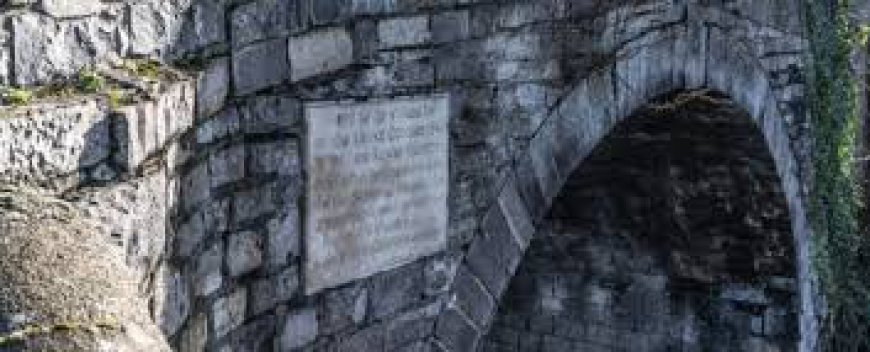How a Genius Formula Carved Onto a Bridge Changed Mathematical History
In the bustling heart of St. Petersburg, Russia, a city teeming with art, history, and architecture, lies a seemingly ordinary bridge—the Liteyny Bridge. It stretches over the Neva River, carrying the weight of pedestrians and vehicles alike as they pass by daily, unaware that beneath the surface of this unassuming structure rests a mathematical statement that has captivated scholars for decades. Carved into the iron framework is a formula that connects a bold moment in history to the abstract, beautiful world of mathematics. The story of this formula, its origins, and its journey onto the bridge offers a profound insight into how mathematics is not just confined to academic halls but can be a symbol of defiance, legacy, and inspiration.

The mathematical formula in question belongs to Niels Henrik Abel, a 19th-century Norwegian mathematician whose work laid the foundation for modern algebra and number theory. Though Abel’s life was tragically short—he died at just 26—his contributions revolutionized mathematics, particularly in his discovery that no general solution exists for the quintic equation. Abel’s genius has been celebrated through academic circles, but the decision to inscribe his work onto a public structure elevated his ideas into a broader cultural dialogue. This act not only honored Abel’s contributions but also called attention to the often-overlooked importance of pure mathematics.
Abel’s Life and Breakthrough:
To understand why this formula holds such significance, it’s crucial to explore Abel’s background and the context in which he made his groundbreaking discoveries. Born in 1802 in Norway, Abel displayed mathematical genius from a young age. Despite his immense talent, he struggled with poverty and illness throughout his short life, often having to scrape together resources to pursue his academic work. Nevertheless, Abel’s passion for mathematics never wavered. His contributions to the field of algebra, particularly his work on elliptic functions and integrals, earned him posthumous recognition as one of the most important figures in mathematical history.
The most famous of Abel’s discoveries came in the form of his proof that no general algebraic solution exists for the quintic equation, an equation of the fifth degree. Mathematicians had previously solved polynomial equations up to the fourth degree, but the quintic equation proved to be resistant to traditional algebraic methods. Abel’s proof, which came to be known as Abel’s Impossibility Theorem, demonstrated once and for all that a solution using radicals could not exist for equations of this nature.
This discovery had far-reaching implications, not only in the world of algebra but also in fields like geometry, topology, and even physics. Abel’s work on elliptic integrals and functions pushed mathematics into new realms of abstraction, inspiring generations of mathematicians who would later build on his discoveries. However, Abel died before his work could be fully recognized, leaving his ideas to be championed by others.
The Importance of the Quintic Equation
To fully grasp the revolutionary nature of Abel’s proof, it’s important to understand the significance of the quintic equation and the broader quest to solve polynomial equations. A polynomial equation, in its simplest form, is an expression involving variables raised to various powers and set equal to zero. The degree of the equation refers to the highest power of the variable in the equation. For example, a quadratic equation is a second-degree polynomial, while a cubic equation is a third-degree polynomial.
By the 18th century, mathematicians had developed methods for solving polynomial equations up to the fourth degree. These methods relied on expressing the solution in terms of radicals, or the roots of numbers. However, the quintic equation—an equation of the fifth degree—eluded even the brightest mathematical minds of the time. For centuries, mathematicians attempted to find a solution, believing that it was only a matter of time before the mystery was solved.
It was Abel, however, who proved that no such solution existed. His proof, published in 1824, showed that it was impossible to solve the general quintic equation using radicals. This groundbreaking discovery marked a turning point in mathematical history, as it paved the way for new approaches to algebra that did not rely on traditional methods. Abel’s work laid the foundation for group theory and modern abstract algebra, which have since become essential tools in understanding everything from symmetry in geometry to the behavior of subatomic particles in physics.
The Journey of Abel’s Formula to the Liteyny Bridge:-
Fast forward to the 1990s, more than a century after Abel’s death, to a time when Russia was experiencing significant political and social upheaval. The collapse of the Soviet Union had left the country in economic turmoil, and funding for scientific research, particularly in theoretical fields like mathematics, had all but dried up. In this environment of uncertainty and instability, a group of Russian mathematicians and physics students decided to take matters into their own hands.
Inspired by Abel’s work and frustrated by the lack of support for pure mathematics, they chose to inscribe one of Abel’s famous formulas onto the Liteyny Bridge. Their actions were not simply an homage to Abel’s genius but also a statement about the enduring importance of mathematics in society. In a time when practical concerns dominated public discourse, and funding for the sciences was increasingly tied to immediate applications, the students’ decision to carve a mathematical formula into a public structure was a bold assertion of the value of intellectual inquiry for its own sake.
The choice of the Liteyny Bridge as the site for the inscription was itself symbolic. Bridges, both literal and metaphorical, are structures that connect disparate places or ideas. In this case, the bridge served as a physical link between the abstract world of mathematics and the tangible, everyday reality of the people who crossed it. The inscription reminded passersby that mathematics is not confined to dusty textbooks or ivory towers—it is a living, breathing discipline with real-world implications.
Elliptic Functions and the Legacy of Abel’s Work:-
The formula inscribed on the Liteyny Bridge belongs to Abel’s groundbreaking work on elliptic functions and integrals, a field that has had a profound impact on mathematics and science. Elliptic integrals, which are used to calculate the length of arcs of ellipses, are crucial in a variety of mathematical applications, from number theory to the physics of motion.
Abel’s work on elliptic functions extended the insights of calculus into new, previously uncharted territories. These functions, which generalize the more familiar trigonometric functions, have applications in fields ranging from electrical engineering to quantum physics. For example, elliptic functions are used to describe the motion of celestial bodies, and they play a crucial role in modern string theory, a theoretical framework that seeks to reconcile quantum mechanics and general relativity.
The importance of Abel’s work in this area cannot be overstated. By developing new ways to approach problems involving elliptic integrals, Abel laid the groundwork for later mathematicians like Carl Gustav Jacobi, who further expanded the field of elliptic functions. Today, Abel’s work continues to influence research in mathematics, particularly in areas like algebraic geometry and number theory.
The Political and Social Context of the Bridge Inscription:-
The decision to inscribe Abel’s formula onto the Liteyny Bridge must also be understood in the context of the political and social climate of Russia in the 1990s. The collapse of the Soviet Union had left the country in a state of economic and social disarray. Institutions that had once been well-funded, including universities and research centers, suddenly found themselves struggling to survive. Theoretical research, in particular, was often seen as a luxury that could no longer be afforded in a time of economic crisis.
The mathematicians and physics students who inscribed Abel’s formula onto the bridge were keenly aware of this shift in priorities. They saw their actions as a form of protest against the diminishing support for pure research and intellectual inquiry. By inscribing a mathematical formula in a public space, they were making a statement about the value of knowledge for its own sake—knowledge that, while seemingly abstract and theoretical, can ultimately transform the world.
In a time when the practical and immediate seemed to dominate public discourse, the inscription served as a reminder that mathematics, with its deep connections to philosophy and the natural world, is a vital part of the human experience. The act of carving the formula onto the bridge was both an homage to Abel’s genius and a call to action for society to recognize the importance of intellectual pursuits, even in times of crisis.
The Enduring Legacy of Abel’s Formula and the Bridge:-
In the years since the inscription, the Liteyny Bridge has become a symbol of the enduring power of mathematics. Mathematicians and scholars from around the world have visited the bridge, drawn by the story of Abel’s formula and the bold act of the students who immortalized it. The bridge stands as a reminder of the profound impact that abstract ideas can have on the world, even when those ideas seem distant from everyday concerns.
Abel’s contributions to mathematics continue to be celebrated in academic circles, and his work has inspired countless discoveries in fields ranging from algebra to physics. Today, the Abel Prize, one of the most prestigious awards in mathematics, is named in his honor, recognizing those who have made outstanding contributions to the field.
But beyond the academic accolades, the story of the Liteyny Bridge serves as a powerful reminder that mathematics is not just about solving equations—it is about exploring the fundamental nature of reality and pushing the boundaries of human knowledge. The inscription of Abel’s formula on the bridge represents a bridge between the past and the present, between theory and practice, and between the abstract world of mathematics and the concrete realities of life.
Conclusion :
The formula carved onto the Liteyny Bridge is more than just a mathematical statement—it is a symbol of resistance, curiosity, and intellectual perseverance. Abel’s work, which reshaped the landscape of modern mathematics, continues to inspire scholars and students alike, while the story of the bridge serves as a testament to the enduring relevance of mathematical ideas.
In a world where science and technology play an increasingly












































